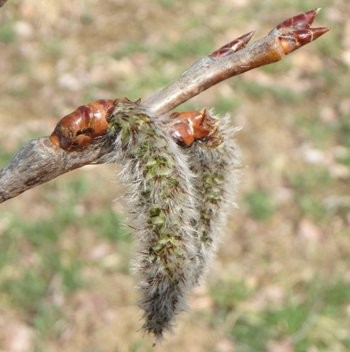Large-tooth aspen
(Populus grandidentata)

Description
Populus grandidentata, commonly called large-tooth aspen, big-tooth aspen, American aspen, Canadian poplar, or white poplar, is a deciduous tree native to eastern North America. The name Populus is from the Latin for poplar, and grandidentata refers to the coarse teeth on the leaves (grandis meaning "large", and dentata meaning "toothed"). Populus grandidentata is a medium-sized deciduous tree native to North America, found mostly in the northeastern United States and southeastern Canada. Leaves are similar to Populus tremuloides, but slightly larger and having larger teeth. The leaves tremble in the wind as P. tremuloides does. Bark of younger trees is olive-green, thin and smooth; after 30–40 years, the bark is gray, thick and rough with grooves. Bigtooth aspens produce seeds from wind-pollinated flower clusters, known as catkins. The tree is dioecious, meaning that male and female flowers are on separate trees, which flower from mid-April to mid-May depending on the climate zone. The seed, a two-valved capsule, is distributed widely by the wind. Seed production begins around 10 years old. Individuals can also reproduce through the roots after a disturbance event, such as fire or harvest; the roots of the dead/cut tree will begin to send up suckers, creating identical individuals, and can result in a stand of clones that resemble that individual. Bigtooth aspens are dioecious, medium-sized deciduous trees with straight trunks and gently ascending branches. Heights at maturity are around 60–80 feet (18–24 m) with diameters of 8–10 inches (20–25 cm). They are fast growing and are relatively short-lived; stands will begin to deteriorate after 60–70 years, while individuals can live up to 100 years. They often constitute early successional species of their landscapes. Roots are shallow and wide spreading; lateral root growth in a forest may be as far as 60 feet (18 m). The range of Populus grandidentata extends from Virginia north to Maine and Cape Breton Island, Nova Scotia; west to southeastern Manitoba and Minnesota; south through Iowa to extreme northeastern Missouri; and east through Illinois, Indiana, Ohio, and West Virginia. Disjunct populations are found in Kentucky, Tennessee, North Carolina, and South Carolina.
Taxonomic tree:







